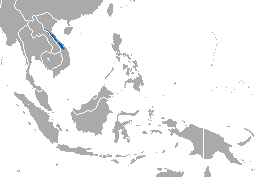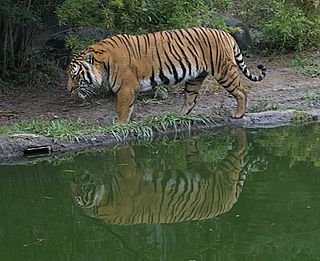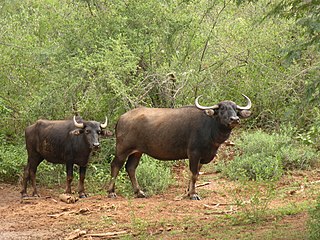
The kouprey, also known as the forest ox and grey ox, is a possibly extinct species of forest-dwelling wild bovine native to Southeast Asia. It was first scientifically described in 1937. The name kouprey is derived from the Khmer language and means "forest ox".

The saola, also called spindlehorn, Asian unicorn, or infrequently, Vu Quang bovid, is one of the world's rarest large mammals, a forest-dwelling bovine native to the Annamite Range in Vietnam and Laos. It was described in 1993 following a discovery of remains in Vũ Quang National Park by a joint survey of the Vietnamese Ministry of Forestry and the World Wide Fund for Nature. Saolas have since been kept in captivity multiple times, although only for short periods as they died within a matter of weeks to months. The species was first reported in 1992 by Do Tuoc, a forest ecologist, and his associates. The first photograph of a living saola was taken in captivity in 1993. The most recent one was taken in 2013 by a movement-triggered camera in the forest of central Vietnam. It is the only species in the genus Pseudoryx.

The Siamese crocodile is a medium-sized freshwater crocodile native to Indonesia, Brunei, East Malaysia, Laos, Cambodia, Myanmar, Thailand and Vietnam. The species is critically endangered and already extirpated from many regions. Its other common names include Siamese freshwater crocodile, Singapore small-grain, and soft-belly.
A rare species is a group of organisms that are very uncommon, scarce, or infrequently encountered. This designation may be applied to either a plant or animal taxon, and is distinct from the term endangered or threatened. Designation of a rare species may be made by an official body, such as a national government, state, or province. The term more commonly appears without reference to specific criteria. The International Union for Conservation of Nature does not normally make such designations, but may use the term in scientific discussion.

The Annamite Range or the Annamese Mountains is a major mountain range of eastern Indochina, extending approximately 1,100 km (680 mi) through Laos, Vietnam, and a small area in northeast Cambodia. The mountain range is also referred to variously as Annamese Range, Annamese Mountains, Annamese Cordillera, Annamite Mountains and Annamite Cordillera. The name "Annam" is the Vietnamese pronunciation and terminology of Chinese: 安南, meaning "the tranquil south" referring to Vietnam. The French adopted the word and used "Annamese" or "Annamite" to refer to the Vietnamese.

The Annamite striped rabbit is a species of rabbit native to the Annamite mountain range on the Laos-Vietnam border. The rabbit is striped, with a red rump, and resembles the Sumatran striped rabbit. It only recently became known to Western scientists: striped rabbits were first observed in 1996 by biologist Rob Timmins in a market in Bak Lak in Laos, and the species was described in 2000 and named after Timmins' find.

Indo-Burma is a biodiversity hotspot designated by Conservation International.

The wildlife of Laos encompasses the animals and plants found in the Lao People's Democratic Republic, a landlocked country in southeastern Asia. Part of the country is mountainous and much of it is still clad in tropical broadleaf forest. It has a great variety of animal and plant species.
The tiger is an iconic species. Tiger conservation attempts to prevent the animal from becoming extinct and preserving its natural habitat. This is one of the main objectives of the international animal conservation community. The Convention on International Trade in Endangered Species of Wild Fauna and Flora (CITES) has played a crucial role in improving international efforts for tiger conservation.

The tribe Bovini or wild cattle are medium to massive bovines that are native to Eurasia, North America, and Africa. These include the enigmatic, antelope-like saola, the African and Asiatic buffalos, and a clade that consists of bison and the wild cattle of the genus Bos. Not only are they the largest members of the subfamily Bovinae, they are the largest species of their family Bovidae. The largest species is the gaur, weighing up to 1,500 kg (3,300 lb).
Nakai-Nam Theun National Park in Nakai District, Khammouane Province, Laos, is one of the last remaining wildernesses in Southeast Asia. Nakai-Nam Theun covers approximately 4,270 km2 of the Annamite Range and the adjacent Nakai Plateau in Khammouane and Bolikhamsai Provinces. It was designated a national park on 15 February 2019 by Prime Ministerial Decree No. 36, 15 February 2019. It is managed by the Ministry of Agriculture and Forestry (MAF). It is adjacent to the Vu Quang National Park of Vietnam.
Vũ Quang National Park is a national park in Vũ Quang District, Hà Tĩnh Province, North Central Coast, Vietnam. This park contains biodiversity. Saola and giant muntjac are species found in this park. Vũ Quang is a remote forested region of Vietnam, in which several new species of deer and antelope have been discovered since the 1990s. Some are so new that scientific description is still pending, although most have local names.
The Phou Hin Poun National Biodiversity Conservation Area, formerly known as the Khammouane Limestone National Biodiversity Conservation Area, is one of 21 National Biodiversity Conservation Areas of the Lao People's Democratic Republic. Located in a limestone tower karst region of the Annamite Range in Khammouane Province, it is home to a number of rare or newly discovered species. National Biodiversity Conservation Areas are not protected by the government of Laos in any meaningful way; the budget for each is about $500. The human population of the NBCA is 29,603.
The Wildlife Conservation Network (WCN) is a United States-based 501(c)(3) non-profit organization that protects endangered wildlife by supporting conservationists in the field who promote coexistence between wildlife and people. WCN does this by providing its partners with capital, strategic capacity-building services, training, and operational support. WCN has been given a top rating amongst wildlife conservation charities, with a four star rating on Charity Navigator.

The Andean Cat Alliance is a network of researchers and conservationists working to study and protect the Andean cat and its habitat in Argentina, Bolivia, Chile and Peru. It is partnered with the Wildlife Conservation Network, and has developed a strategic plan for conservation of the species.

Bolikhamsai is a province of Laos. Pakxan, Thaphabat, Pakkading, Borikhane, Viengthong, and Khamkeut are its districts and Pakxan is its capital city. The province is the site of the Nam Theun 2 Dam, the country's largest hydroelectric project.

Many areas of Vietnam are under protection. While the national reserves cover small areas of scientific significance with restricted access, the national parks also cover wetlands of Ramsar designated areas and BirdLife International inscribed bird areas. The largest of the national parks initially covered were the Cúc Phương National Park, the Cát Tiên National Park, and the Côn Đảo National Park which to start with were forest areas cum reserves or prohibited areas. The objective for creating national parks was to allow access to the reserved areas as a part of ecotourism and cultural needs with full attention to the basic approach of conservation of natural environmental resources.

Bubalina is a subtribe of wild cattle that includes the various species of true buffalo. Species include the African buffalo, the anoas, and the wild water buffalo. Buffaloes can be found naturally in sub-Saharan Africa, South Asia and Southeast Asia, and domestic and feral populations have been introduced to Europe, the Americas, and Australia. In addition to the living species, bubalinans have an extensive fossil record where remains have been found in much of Afro-Eurasia.

Saigini is a tribe of artiodactyl mammals of the Bovidae family, subfamily Antilopinae, comprising two species of medium-sized antelopes that inhabit the Eurasian steppes.

The Northern Annamites rain forests ecoregion covers the rugged and relatively unexplored northern Annamite Mountains of central Laos and Vietnam. There are high numbers of endemic plant species, and the relative remoteness and isolation of the area supports many rare and endangered animals. Rainfall is somewhat less than the lowland rainforest of the lower elevations in Vietnam, and the temperatures slightly cooler due to the higher elevation.













